The Fumble That Changed Football: Miracle at the Meadowlands, 40 Years Later

Harry Carson sat on the back of the bench on the deserted New York Giants sideline. Hunched over. Staring blankly. The future Hall of Fame linebacker did not move for 15 minutes, though it seemed like an eternity. One thing he did notice was that the fans still inside Giants Stadium were similarly frozen.
Numb.
The stadium had been full not long before that, though many fans had already made their way out, hoping to get a jump on the traffic as the Giants ran out the clock in what would be a win over the Philadelphia Eagles. Those who remained got to witness perhaps the most famous example in NFL history of a team snatching defeat from the jaws of victory.
Carson, then in his third season and already establishing himself as one of the league’s dominant inside linebackers, blocked a field goal that day. Still, he cannot recall that—or anything else that happened before or after The Fumble.
Even without having watched the replay a million times since then, he can easily close his eyes and see Eagles cornerback Herman Edwards scoop up the ball and run it in for the game-winning touchdown. But that’s it from that day. He remembers that play, and he remembers sitting there on the bench in stunned disbelief.
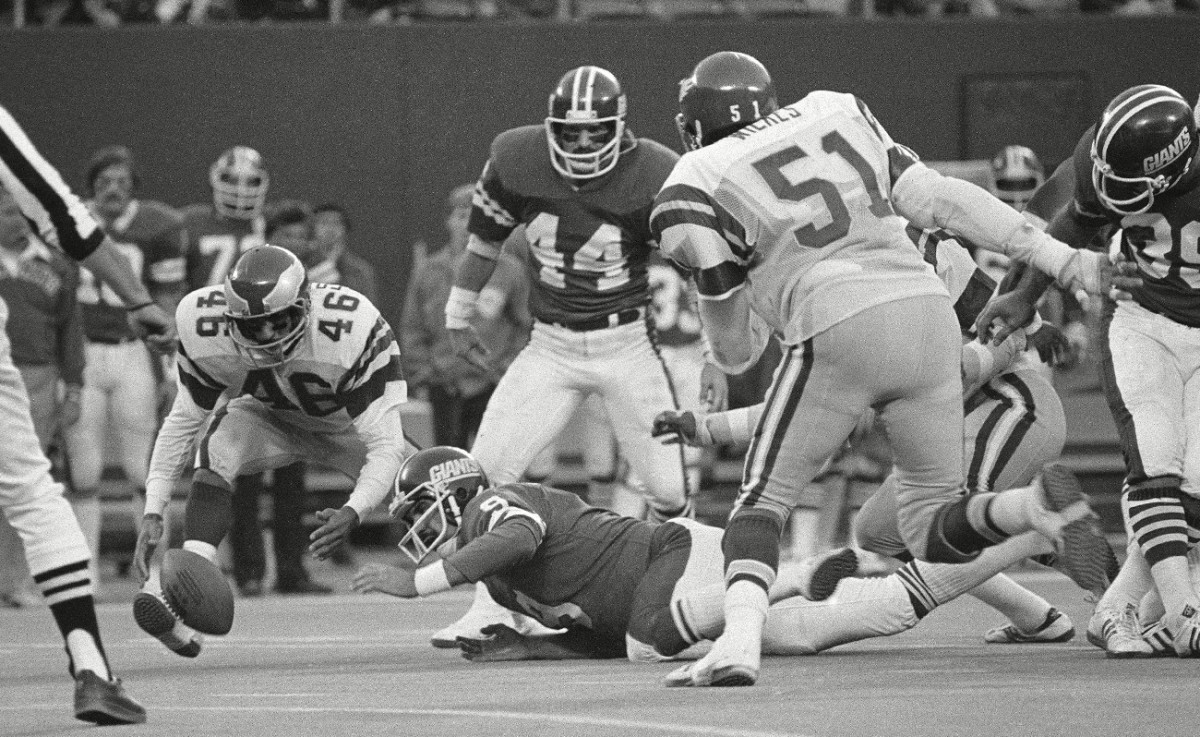
Historic games are often given a nickname to cement their place in NFL lore. “The Immaculate Reception” … “Ghost to the Post” … “The Catch.” This game, which took place 40 years ago, on Nov. 19, 1978, is so big it earned two nicknames: “The Fumble” and “The Miracle at the Meadowlands.”
Unlike most games that deserve nicknames, this one didn’t decide anything definitive. It was a humdrum Week 12 contest between two middling teams. But the result would set in motion a chain reaction that deeply impacted both teams.
We’ve all seen the play: The Giants have the ball and a 17-12 lead over the Eagles, who are out of timeouts. New York can run out the clock by taking a knee, but inexplicably call for a handoff. Quarterback Joe Pisarcik takes the snap and loses control of the ball before he can place it into the waiting arms of fullback Larry Csonka. The ball drops to the turf, taking an absolutely perfect bounce into the hands of Edwards, who effortlessly breezes 26 yards for the game-winning touchdown.
To many, it is perhaps the greatest NFL blooper of all time. In fact, it was much more.
“It is far more significant than people think it is,” said longtime broadcaster Don Criqui, the play-by-play man for CBS’s broadcast of the game. “Looking back, in large measure it changed the whole structure of the National Football League in its most important market, New York.”
Based on what happened in the game’s aftermath, it’s not wrong to say “The Fumble” was the best thing that could have happened to the Giants franchise. It was also pretty significant for the Eagles—more than just a memorable fluke win.
Going into the 1978 season the Giants hadn’t been to the playoffs in 14 years, with only two winning seasons in that stretch. The Eagles were working on a 17-year playoff drought, also with just two winning seasons in that span.
Both teams had head coaches in their third season on the job—John McVay for the Giants and Dick Vermeil for the Eagles. New York entered the game with a 5-6 record; Philadelphia was 6-5.
As the game began, the CBS broadcast team of Criqui and Hall of Fame quarterback Sonny Jurgensen discussed the fact that Pisarcik, the second-year Giants starter, was questionable to play. In addition to fighting the flu, he also had a sore knee. Nevertheless, Pisarcik threw a pair of first-quarter touchdown passes, and the Giants led 14-6 at halftime.
“He may be a little under the weather,” Jurgensen said on the telecast, “but I’ve never seen him throw better.”
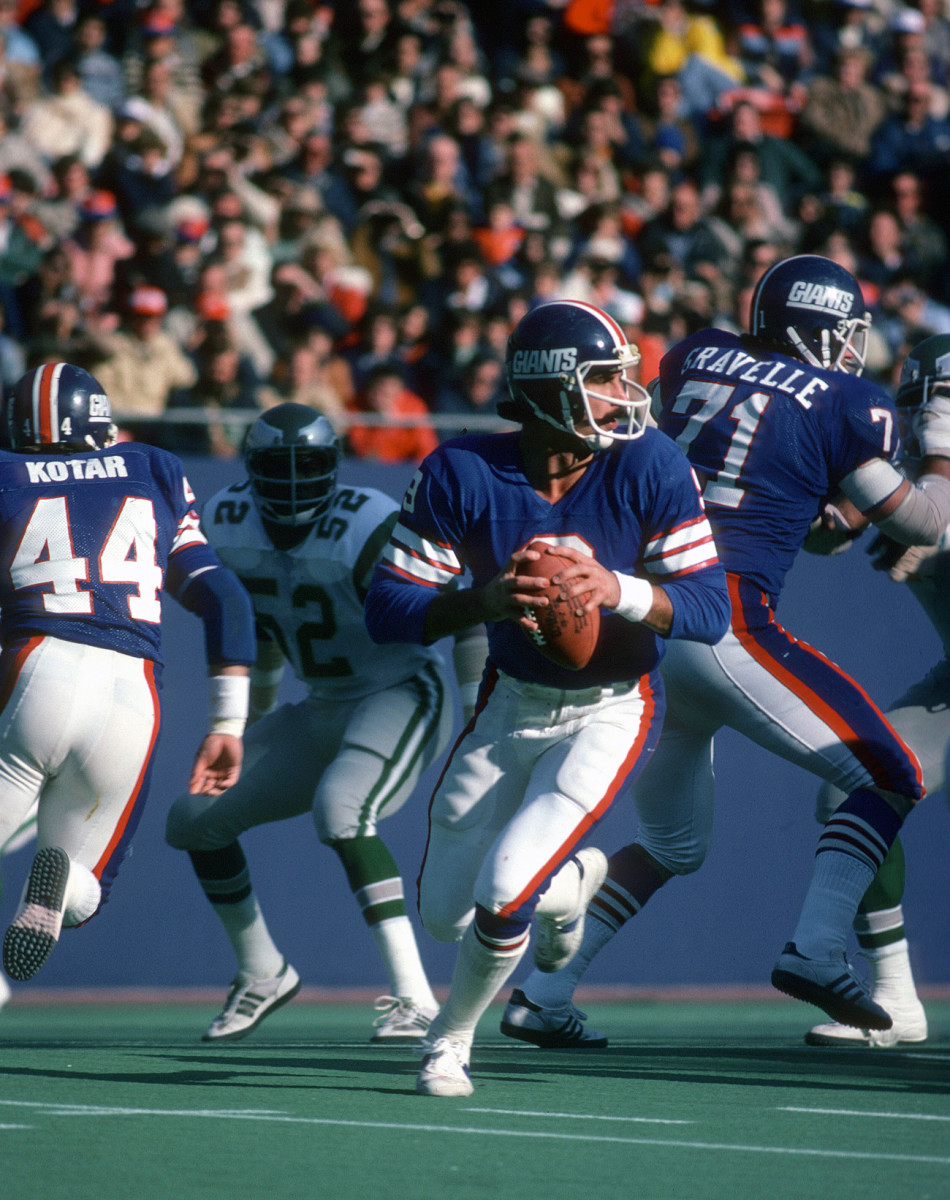
Passing wouldn’t be Pisarcik’s problem on that fateful day. For the record, he completed 13 of 23 for 181 yards, those two TDs and one interception. The Giants led 17-12 late in the fourth quarter when running back Doug Kotar fumbled deep in New York territory to give the Eagles a shot. But when Philly quarterback Ron Jaworski was intercepted by Odis McKinney with 1:23 remaining, the game was all but over.
Or so it seemed.
What preceded this epic fail? First, keep in mind that “victory formation” wasn’t formally allowed in the NFL until 1987. The practice to kill a play was for a quarterback to drop back and fall to the ground. He still had to be touched by a defender, though there was an “unwritten rule” that this was done passively. When Pisarcik rolled to the ground on first down of the series, Eagles linebacker Frank LeMaster charged at running back Willie Spencer and shoved him into Pisarcik. Linemen on both sides began jawing contentiously before order was restored and the Giants huddled up for second down.
“It got a little heated,” recalls Edwards, then in his second season.
ORR:The Greatest Team Never to Make It—An Oral History of the ’98 Vikings
The Eagles used their last timeout with 1:11 left. On second-and-13, Giants offensive coordinator Bob Gibson, perhaps concerned for Pisarcik’s safety, called for a handoff to Csonka, who carried up the middle for 12 yards. On third-and-1 from the 29, Gibson sent in another handoff. Csonka questioned the call, but Pisarcik wouldn’t change it—he’d been dressed down by Gibson just a week earlier for changing a play.
As they broke the huddle, Edwards noticed Pisarcik and Csonka looking at each other. He knew something wasn’t right, suspected this wouldn’t be a kneel-down. Edwards crept toward the line ready to make a play.
“When I saw the ball being bobbled, my curiosity kinda rose,” Edwards says. “Once it hit his hip and I saw the ball getting ready to hit the ground, my thought process was, I’ve gotta get it on the first bounce. You do these drills that the coaches teach you, like fall on the fumble. That was never even a thought. I just thought, Get it on the first bounce and run it in for a touchdown.” That’s what he did.
“I don’t believe it!” was all Criqui could say.
Final score: Eagles 19, Giants 17.
“It’s a miracle,” Dick Vermeil recalls thinking at the time. “That’s why they call it the Miracle at the Meadowlands. You know as a coach that should never happen, but it did.”
Carson already had it in his head after the McKinney interception that the Giants had won. “I was stunned,” he says. “All we had to do was run out the clock. And the thing that I remember was that I was so stunned that I could not get up from the bench when the game was over. Players walk off the field, walk across the field to congratulate the other team. I was stuck in my seat and could not move.”
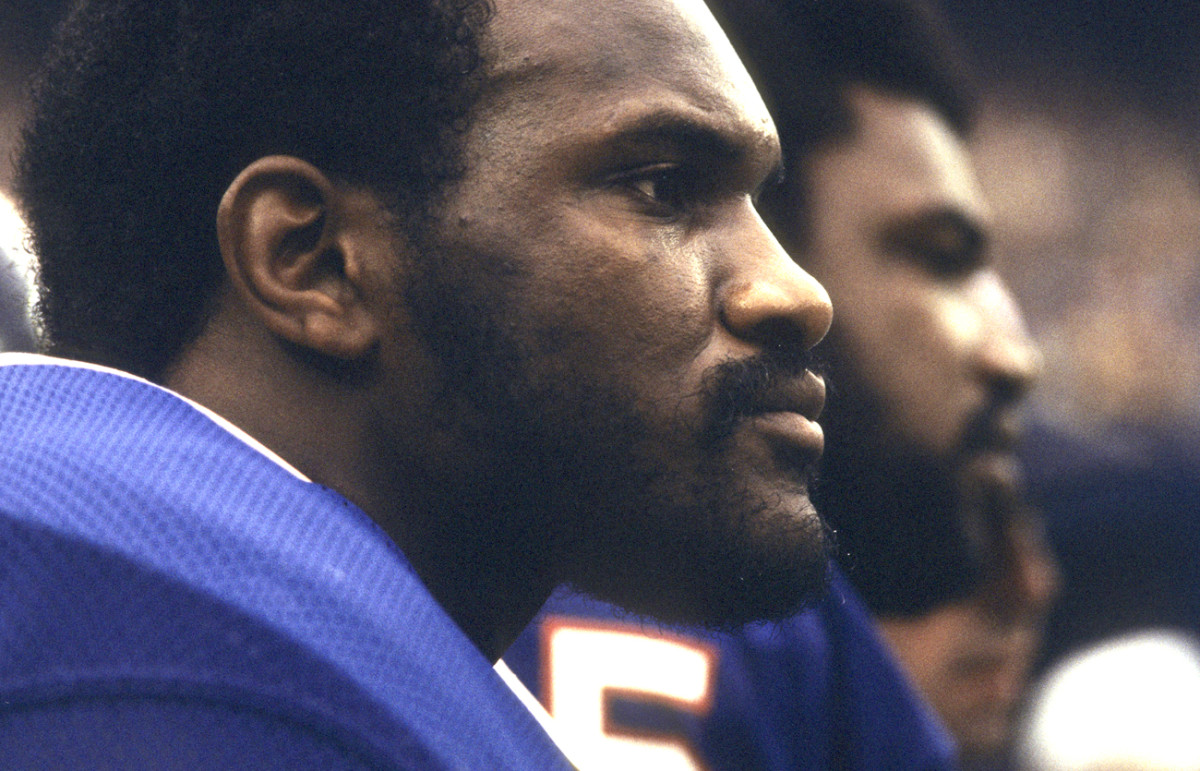
There were four more games to be played that season. Carson recalls none of them. But he remembers the atmosphere around the team, the feeling of dread. “The coaches knew they were dead men walking,” Carson says.
Indeed, their days with the Giants were numbered—though aside from some people losing their jobs, it really was the best thing that could have happened to the organization. Here’s a chronological look at the aftereffects of The Fumble, in the days, weeks and years that followed for the Giants:
• One day later, Gibson was fired.
• After losing three of their final four games to finish 6-10, McVay and his staff, along with general manager Andy Robustelli and the rest of the front office, were fired at the end of the season.
THE THROWBACK:John Mara, future Giants owner, was the spotter for CBS’s broadcast of The Miracle at the Meadowlands
• Because feuding Giants owners Wellington Mara and his nephew, Tim Mara, could not agree on a new GM, NFL commissioner Pete Rozelle stepped in and helped them settle on a candidate neither side had championed: George Young.
• Within two months on the job, Young hired Ray Perkins as head coach and used his first-ever draft pick to select an unheralded quarterback from tiny Morehead State University—Phil Simms. Says Carson: “While I hated Ray Perkins at the time because he was really hard-nosed, a hard-ass coach, in retrospect he was probably the best coach we could have had to instill a sense of discipline in the players.”
• Two years later, in 1981, the Giants drafted Lawrence Taylor. All he did was win NFL Defensive Player of the Year as a rookie. The defense improved from 24th in the league to third, and New York made the playoffs for the first time since 1963.
• After the 1982 season, Perkins replaced Bear Bryant at his alma mater, Alabama. Charged with hiring a head coach for the second time in his career, Young promoted linebackers coach Bill Parcells to the job.
• From that point, the Giants became one of the most consistently successful franchises in all of football, reaching the Super Bowl five times and winning four titles over the next 29 years.
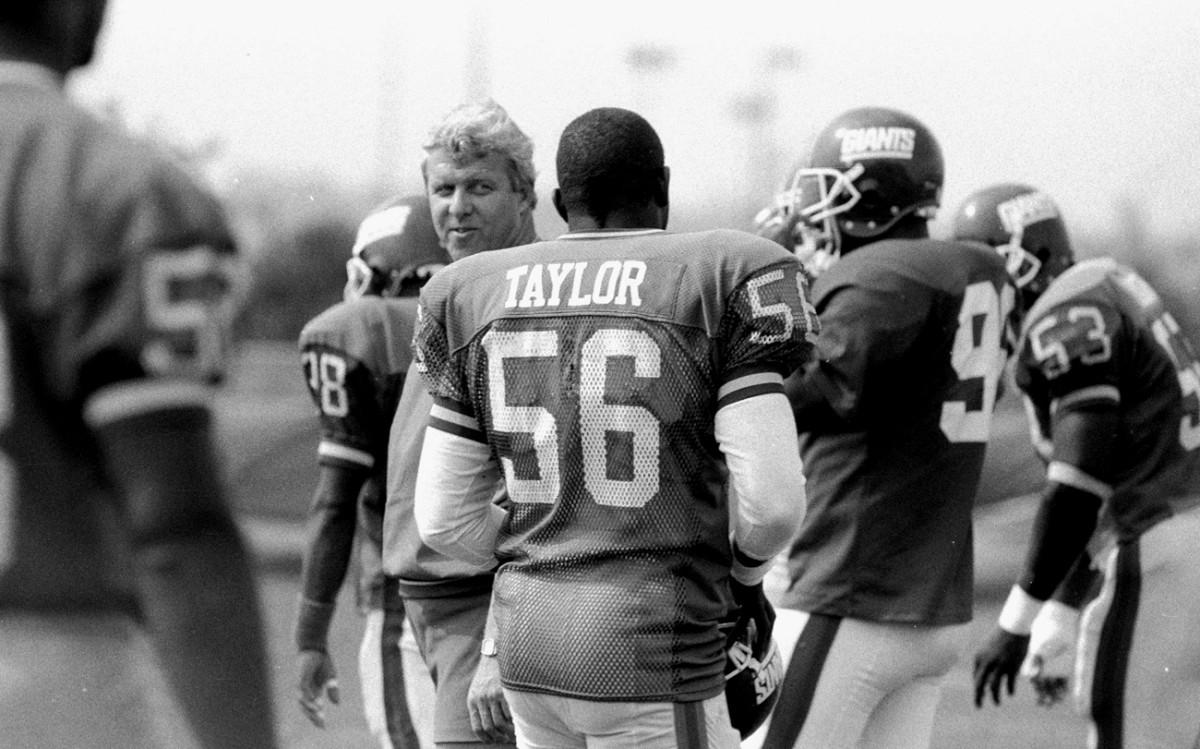
Would any of that have happened if the Giants didn’t implode in ’78? If “The Fumble” never happened, they would have been 6-6 and riding a bit of momentum going into the final four games. If they’d finished 8-8, would they have cleared the decks the way they did?
“I’ve heard some over the years say ‘The Fumble’ turned around the fate of the franchise, and I agree with that,” says Simms. “It just made the Giants change how they run their football team, and it definitely made them better.”
The Giants ownership at the time was a 50-50 split between Wellington and Tim Mara, who inherited his half of the team when his father, Jack, died in 1965. Wellington had been the hands-on owner, while Tim and his family were objective observers … until Nov. 19, 1978.
BASKIN:The Worst Game in NFL History, and the Best Game Lawrence Taylor Ever Played
“Everything changed,” says Criqui, who also broadcast Giants preseason games and was close to the Mara family. “The side that was quiet about running the Giants said, ‘Now it’s our turn to start making decisions.’”
But the two sides did not get along—there were separate owners boxes at Giants Stadium—and they could not agree on the right person to rebuild their franchise. With one of the league’s marquee teams in disarray, the league office intervened. It was Rozelle who handpicked Young, the director of pro scouting under Don Shula with the Dolphins.
A student of government affairs, Young instituted a system of checks and balances in the front office. He modernized and upgraded an organization that had been stuck in the past. He immediately took to the road and started scouting players. A few months later, he made Simms—Phil Who? was the general reaction in the New York papers—his surprise first draft pick, seventh overall.
“I didn’t know anything in particular about the Giants,” Simms says. “I knew Charlie Conerly, Y.A. Tittle, Fran Tarkenton all played there. And, of course, everybody knew about ‘The Fumble.’
“As I tell everybody, that’s the reason we were all here—Ray Perkins, myself, George Young. We were all there because of ‘The Fumble.’ What did I know about it? Nothing, just what I saw on TV. I didn’t read anything in depth, didn’t think about what a big deal it was. I think the biggest thing was the chain reaction it created—not only by the Giants, the fans, but the NFL itself—who, as we’ve learned through history, stepped in and told the Giants, ‘Okay, you need to change a little.’ ”
KAPLAN:That ’70s Strike—a Look Back at the NFL’s Funky, and Failed, First Labor Stoppage
These days, long-time losing franchises talk about rebuilding with concepts like “changing the culture of the locker room.” For George Young’s Giants, it was simply a matter of finding talented players and good coaches and getting them to work together. By 1986 the Giants were Super Bowl champions. Simms was the Super Bowl XXI MVP. Taylor was the regular-season MVP, and Defensive Player of the Year (for the third time). Carson, who went to his eighth Pro Bowl that season, was one of the only players on the Super Bowl XXI roster that was not there because of Young.
“But I don’t think George Young would have been part of the equation had it not been for ‘The Fumble,’ had it not been for the differences in opinion between the Mara family and that whole 50-50 split of the organization,” said Carson.
It’s also worth noting the lasting effect this game had on the Eagles. The immediate impact was clear: After splitting their last four games of the season, they finished 9-7 and made the postseason as a wild card, ending their 17-year playoff drought. If not for “The Fumble,” the Packers, at 8-7-1, would have claimed that last playoff spot, and Philly’s playoff futility would have continued.
The Eagles lost to Atlanta in the wild-card game that year. The following season they went 11-5 and advanced to the divisional round. A year after that they were in the Super Bowl.
So was “The Fumble” a building block toward that success?
“When you’re a losing team, every win is a building block—and a win like that is two or three blocks,” says Vermeil. “It’s a great way to make sure your players always know they still have a chance to win.”
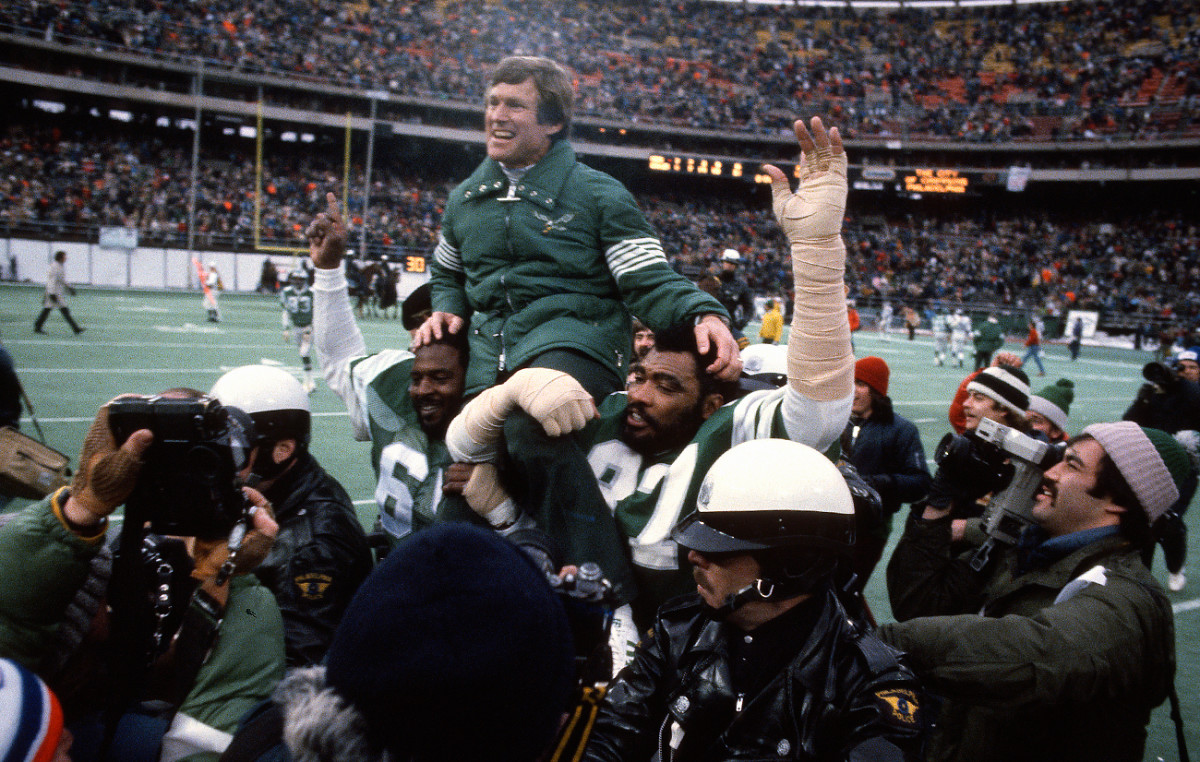
Edwards remembers that the Eagles didn’t win many games in 1977, his rookie season, but they were close. And they learned how to win close games in 1978—by miracle or otherwise.
“I think that play kind of gave us this confidence that, you know what, we can win games when it’s the fourth quarter and it’s tight,” said Edwards. “Somebody just needs to make a play. From that point on, we were that kind of team—we found a way to win games. From that play on, we had a pretty good run as a football team.”
POMERANTZ:Mean Joe vs. Double O—Joe Greene, Jim Otto and the Steelers-Raiders Rivalry of the ’70s
Edwards had a pretty good run of his own. He was one of 12 players on the field that day at the Meadowlands who played for the Eagles in Super Bowl XV (losing to the Oakland Raiders) two seasons later. After a 10-year playing career, Edwards was a head coach for eight seasons with the Jets and Chiefs. His most memorable moment as a coach might have come during a 2002 press conference with the Jets, when he famously declared:
“You play to win the game!”
That profound philosophy certainly empowered Edwards when he saw the football escaping Pisarcik’s grasp. Just don’t tell him there was any luck involved in that ball bouncing so perfectly into his arms.
DALY: Sammy Baugh 1943—The Greatest Season?
“Some people say, ‘Well it’s luck.’ And you know what I say? You know what luck is? Luck’s hard work. And when you work hard, and you’re diligent, there’s gonna be things that kinda go your way at times.”
Just another play for a guy who was always around the football.
Edwards ended his NFL playing days with two career touchdowns—both against the Giants. He could have scored 50, and it’s hard to imagine any would have been as significant as the one that came on November 19, 1978.
It laid the groundwork for the Eagles’ Super Bowl run two years later. It changed everything for the Giants, and set them on course to become a long-term winner. It made evident the risk of handing the ball off when the game is essentially won, ultimately ushering in the victory formation and the rule change permitting the quarterback to declare himself down by kneeling with the ball. It even helped the San Francisco 49ers—a year after McVay was fired, he became VP/head of football operations with the Niners and played a key role in five Super Bowl winners.
“I don’t think people realize the enormity of that one play on the National Football League,” said Criqui. “A lot of people think, ‘Gee, it cost the Giants the game and they fired some people because of it.’ But it was groundbreaking.”
Veteran NFL journalist Craig Ellenport is currently editor-in-chief of HeadCoachRanking.com. Craig's uncle, a longtime Giants season ticket-holder, was walking to his car in the Giants Stadium parking lot when The Fumble occurred.
Question or comment? Email us at talkback@themmqb.com.
